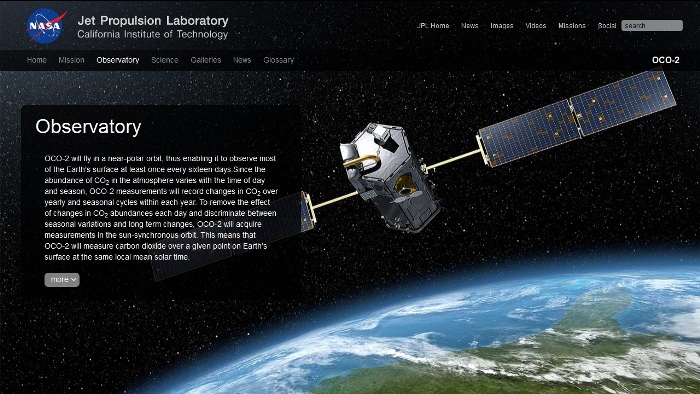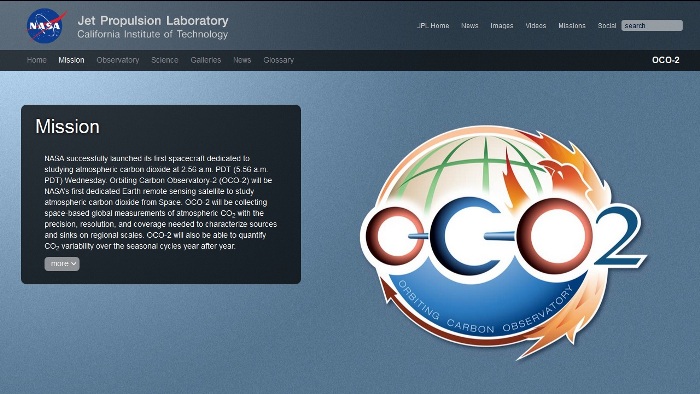NASA Successfully Launches Carbon Measuring Satellite after the 2009 Failure
This sounds odd. We’ve had telescopes that can identify different kinds of gases in planets and other heavenly bodies that are light years away. However, it appears we didn’t have satellites that can detect carbon in our atmosphere until NASA announced the launching of “its first” earlier this week? As Bloomberg reported in June, NASA was set to launch the FIRST satellite to chart carbon levels in the Earth’s atmosphere. The “first” part, just like how many news sites wrote it, does not really seem that believable. Maybe we already had similarly capable satellites before but they’re just not comparable to the scale and cost of the one recently launched.
Anyway, the satellite was officially launched at 2:56 AM on Wednesday through the Delta 2 rocket that blasted off from California. The satellite separated from the rocket after 56 minutes, in low-earth orbit. The flight was described by the satellite’s project manager, Ralph Basilio, as “a perfect ride into space.” We can’t blame them for feeling that slightly exaggerated. NASA’s first attempt at launching a similar satellite ended in a major failure. Around five years ago, NASA lost a similar satellite as it took a nosedive (during the launch) into the Antarctic ocean. The failure was attributed to a hardware failure in the rocket used. Now, success is at hand. This must be the explanation on the hype of “NASA’s FIRST carbon measuring satellite.”
Orbiting Carbon Observatory-2 (OCO-2)
The satellite recently launched is called the OCO-2, one of NASA’s most important satellites costing around $465 million. It is designed to gather a more comprehensive view of the human and natural sources of carbon dioxide in different parts of the world. It also seeks to find the areas called “sinks” where carbon dioxide is absorbed.
Earlier estimates put the Earth’s carbon dioxide production at 40 billion tons per year. This comes from the burning of fossil fuels and a number of other human activities. Around half of this amount of emissions are naturally absorbed by the oceans and by plants. However, with recent developments, things may have dramatically changed. Carbon dioxide emissions steadily rise while the Earth’s ability to absorb likely degraded.
The successful launch of OCO-2 will provide more reliable numbers to facilitate climate change discussions. OCO-2 will particularly present a clearer picture of the actual amount of carbon dioxide humans contribute to the environment. Likewise, it will provide more sensible bases in determining the right approaches in addressing climate change or global warming. The more accurate figures it can generate should offer more compelling arguments in convincing governments worldwide to do their respective parts in curbing carbon emissions.
How OCO-2 Works
The newly launched carbon-tracking satellite works by examining the wavelengths of sunlight absorbed by carbon dioxide. The satellite is 438 miles above the Earth’s surface and does measurements through advanced cameras and sensors. Its polar orbit is estimated to enable an 80% coverage, allowing the satellite to have a glimpse of greenhouse gas developments in most parts of the world. After the successful launch, the satellite is now a part of a loose formation of other satellites informally referred to as the “A-Train.”
OCO-2 aims to densely sample the Earth’s atmosphere once every 16 days for a minimum period of two years. According to OCO-2 program executive Betsy Edwards, the satellite’s comprehensive reach and rigorous sampling will provide a picture of the world’s atmospheric carbon dioxide levels with “unprecedented level of coverage and resolution.” Through OCO-2, NASA aims to measure carbon dioxide concentrations in the atmosphere with a sensitivity of one part per million (1 ppm).
When Will Data Be Available?
The data gathered by the satellite will be processed and presented early next year, according to the satellite’s project manager. However, they will not be presented as they come directly from the satellite. The data obtained will likely be combined with data from other sources including those from Japan’s Greenhouse Gases Observing Satellite. Additionally, the data gathered by OCO-2 will be compared to those of the National Oceanic and Atmospheric Administration’s (NOAA) ground-based observation system. Before OCO-2’s launch, NOAA is regarded as the world’s most dependable source for information on global greenhouse emissions.
NOAA, in partnership with the World Meteorological Organization, is able to obtain data through 150 sites worldwide but these sites are deemed insufficient in covering the real situation worldwide. OCO-2 is expected to fill the gaps especially in seeing through parts of the cloud-covered atmosphere that are not visible to ground-based observation facilities.


